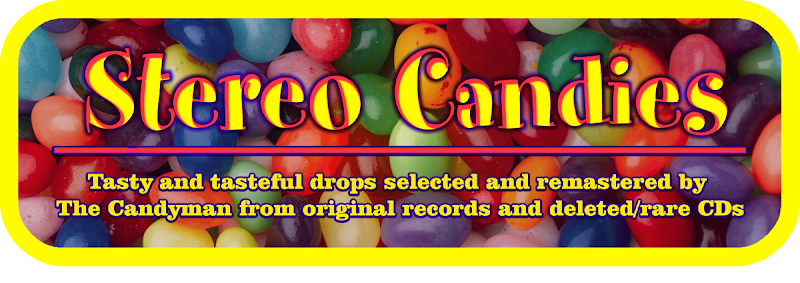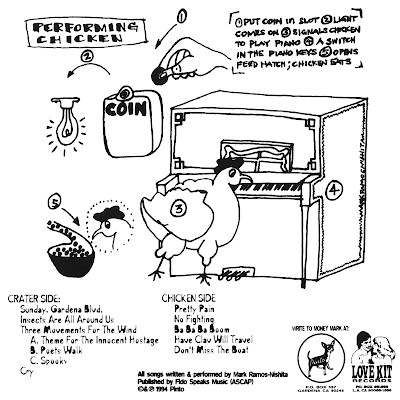[from the liner notes of "Wall of Sound"]

...well, that is - of course - an overstatement, an hyperbole used to create a strong impression in the people flipping through the vinyls stacked in record shops in those glorious days during the early '70s... But it's undeniable that the mysterious Adam Best - or anyone who has chosen to hide behind that name for some unknown reason - has crafted a little groovy record that can still make a good impression more than forty years later.
So, who was Adam Best? According to Mista Tibbz, «...there is strong suspicions of his relations to Music De Wolfe sound libraries due the similarity in certain library records and this one, but nothing is proved...».
Some people discussing in an Internet forum - here - link Adam Best to Barry Stoller, a composer of Library Music who is better known for the theme he created for "Match of the Day", the popular BBC's football television programme. It seems that Meatball's "Atomic Butterly" features a backing track identical to one of those contained on "Wall of Sound" with different solos over the top... Uhm, I would be quite curious to listen to that record...
Anyway, the only certainty I can offer is that the album liner notes mention veteran composer and director Harold Geller's involvement in the making of the record. Then we have the fact that the original six compositions on "Wall of Sound" - the other six are covers of famous tunes - are signed by Hugh Cortley and a certain Supran. Well, I guess I should write five originals and seven covers since one of the originals seems to be a plagiarism... More on this if you continue to read below.
I wasn't able to find anything relevant about Supran, but Cortley is often associated with Musi Silvio, another Library Music composer. Their tune entitled "Export" (...available here...) is very similar to the material contained on "Wall of Sound"; it is included on the album "New Generation" credited to The Laurence Stephen Orchestra...

Here's a complete transcription of the original liner notes that appear on the back cover of "Wall of Sound":
«Once in a while a person or group of people comes along with a style of music which surpasses anything done before. They are usually self-centred ruthless people - they don't get results unless they are - who know to the letter what they want, and nothing is allowed to stand in their way. Such a man is Adam Best. 24 year old Adam Best studied electronics at college, and music at the Royal Academy. He has been playing guitar, bass and drums on the pop scene for a number of years, but it was not until 14 months ago that he gave up playing in public to concentrate full-time on his own project. He was aided by one Harold Geller, one of London's most successful music directors and publishers, who recognised that his ideas were valid, and encouraged him to begin work on the new sound. Electronic music is not in itself new. People have been making musical sounds with electronics for years, but the great majority of it can hardly be called music, for it lacks - for want of a better word - soul. For the first time a musician entered the field, with the knowledge of electronics and the knowledge and ability of musician. The sound he has manufactured successfully fills the gap between vocal and instrumental music, based on the solid rhythm foundation played by Adam, augmented by section work by electronics. Just over a year ago Adam began work in a North London coal cellar to build by hand the machines he needed to complete his work. The things he required were not commercially manufactured so everything had to be designed and constructed by him. What little spare time was available was spent in discotheques up and down the country listening and learning from the types of music that were popular. The idea was to provide music that was danceable, and at the same time made pleasant listening. This was achieved by many hours of sessions between Harold Geller and Adam Best and many long involved telephone calls at all odd hours of the day and night when one would think of an idea which would immediately have to be put down in sound. They both laughingly refer to their nocturnal sound effects with neighbours thinking that a crime has been committed when they hear the weird noises emanating from their various houses in the still of the night. However, on reflection, they both feel that it was all very worthwhile. How well he succeeded can be gauged from the reactions of Philips Records. On hearing the first tracks played to them by Adam and Harold Geller, they immediately asked that they were given the opportunity to release all forthcoming material. The first complete Album "Wall of Sound" was presented to them in January, and was immediately scheduled for rush-release. Adam's dream had at last proved worthwhile. The first album is just the beginning for Adam; the sound can only get better. There are no limits on the medium, it is as much or as little as he chooses to make it, and the "Wall of Sound" Adam Best created may well prove to be the most significant musical event of the '70s.»

"Wall of Sound" contains the following tracks:
01. Wall of Sound (5:21)
02. I Can't Go On Without You (2:09)
03. I Guess I'll Always Love You (2:46)
04. Twenty Five Miles (3:09)
05. Lana's Past (2:32)
06. Gimme, Gimme Good Lovin' (1:57)
07. I'm a Man (3:06)
08. Walk Away Renée (2:39)
09. High In Grass (3:21)
10. When You're Young and In Love (2:33)
11. You Shouldn't Say (2:36)
12. Spread Out (3:02)
All tracks were remastered from the original vinyl in May 2013 and are available in FLAC lossless format or high-quality 320 Kbps MP3 files. Both formats include complete printable artwork as PDF files. Please have a look at the comments for the download links.

So, let's explore this Funky / Easy Listening little gem... The album opens with the title track; clocking at over five minutes, "Wall of Sound" is the longest number and probably the coolest original composition too: sustained by forceful guitars and a raw rhythm section, keyboards (...Hammonds? Moogs?) are the undisputed leaders here, as on the rest of the record.
"I Can't Go On Without You" is another original composition, a short Easy Listening number with a more polished sound. It is followed by "I Guess I'll Always Love You", a cover of a 1966 Motown hit by The Isley Brothers which was also recorded by The Supremes. The Isleys' version was reissued in the U.K. in 1969 and became a hit there, hence probably the inclusion on this early 1970 album.
In 1968 "Twenty Five Miles" was a huge hit for Edwin Starr, who co-wrote the song along with Johnny Bristol and Harvey Fuqua. This instrumental version begins with a short break and keeps in line with the hectic nature of the original uptempo beat; one of the best tracks on the album.
"Lana's Past" is another original mellow tune written by the Cortley / Supran team that remains in an Easy Listening territory which doesn't add much to the album's recipe... Side One finishes with "Gimme, Gimme Good Lovin'", a cover of a 1969 hit by Crazy Elephant, a short-lived American Bubblegum Pop band.

Side Two opens with a great cover of "I'm a Man", a 1967 Hammond organ-driven Blues Rock single by The Spencer Davis Group written by Steve Winwood and Jimmy Miller. This song was sampled by DJ Format on his album "Music For the Mature B-Boy" in 2003. It is followed by the cover of another tune taken from the immense Motown catalogue: originally made popular by The Left Banke in 1966, "Walk Away Renée" became a hit for the Four Tops in 1968.
"High In Grass" is a track signed by Cortley / Supran which sound very similar - if not a plain plagiarism - to "Cold Sweat" by James Brown... "When You're Young and In Love" was written by Van McCoy and brought to success by Ruby & The Romantics in 1964, and later also by The Marvelettes in 1967; during the '70s it was covered by many other artists.
"You Shouldn't Say" is another high-quality original composition; I'm quite sure that its breakbeat has been sampled and used by someone during the '90s, probably Beck or Imani Coppola, I will investigate and update the post at a later date if I'm successfull.
The album ends with "Spread Out", an average track which doesn't affect the album as a whole: a nice combination of Funk / Soul and Easy Listening with some real standouts!

The only available picture of the mysterious Adam Best...

The following videos offer a preview of the remastered album: enjoy "Wall of Sound", "Twenty Five Miles", "I'm a Man" and "You Shouldn't Say"!

A few more information about "Wall of Sound" and related people is available here:
http://taukojalka.com/mrtibbz/2011/02/05/adam-best-wall-of-sound/
http://www.whosampled.com/sample/view/196954/DJ%20Format-English%20Lesson%20%28Remix%29_Adam%20Best-I%27m%20a%20Man/
http://www.turnipnet.com/mom/haroldgeller.htm
http://www.verygoodplus.co.uk/showthread.php/1411-Barry-stoller
http://www.librarymusicinfo.com/?s=barry+stoller&searchsubmit=
http://www.discogs.com/artist/Barry+Stoller
http://www.discogs.com/Meatball-Atomic-Butterfly/release/1814004
http://www.librarymusicinfo.com/1043/new-generation-dwlp-3160/

If you have any other useful information about Adam Best and "Wall of Sound" - especially corrections and improvements to this post - or if you spot any dead links, please get in touch with me at stereocandies [at] hotmail [dot] com or leave a comment in the box below, thank you!






